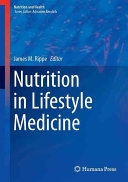The importance of nutrition in medicine is increasingly being discussed.  In response, a new book was compiled entitled Nutrition in Lifestyle Medicine edited by Dr. James Rippe. In it, my wife and colleague Dr. Michelle Bohan Brown and I wrote a chapter about “Critical Evaluation of Nutrition Research.”
In response, a new book was compiled entitled Nutrition in Lifestyle Medicine edited by Dr. James Rippe. In it, my wife and colleague Dr. Michelle Bohan Brown and I wrote a chapter about “Critical Evaluation of Nutrition Research.”
The chapter walks through a number of challenges in evaluating and communicating research in general and nutrition in particular. We try to keep the topic lighthearted, with the hope that encouraging critical evaluation will not induce unabashed cynicism.
After presenting a talk for the ConAgra Food Science Institute Nutri-bites Webinars organized by Dr. Rippe entitled, “In the Eye of the Beholder: Critical Evaluation of Nutrition Research,” I was honored to be invited to contribute a chapter on a similar topic. This topic is one that Michelle and I have conducted research on, such as our paper about the reporting of the relationships between skipping breakfast and obesity. I was delighted we were able to work together again on this chapter.
Two examples come to mind from this chapter. In the first, we discuss a paper that looked at the effects of whole versus processed foods in a randomized design. The randomized design is great, but any nutrition scientist would likely wonder which whole or processed foods were investigated. In fact, the study was about two different cheese sandwiches, which Michelle referred to as “The Tale of Two Cheese Sandwiches.” We make sure to highlight the good aspects of the design, while using it to demonstrate the limitations and difficulties of trying to study complex topics like whole and processed foods.
The second example is a proposed new (or possibly refinement of an existing) logical fallacy: reductio ad tabacum. This is a take on the idea of false analogies, building on the commentary of Strauss:
Unfortunately, it does not go without saying that in our examination we must avoid the fallacy which in the last decade has frequently been used as a substitute for the reductio ad absurdum: reductio ad Hiterlum. A view is not refuted by the fact that it happens to have been shared by Hitler.
Of late, everything is being compared to tobacco, where declarations are made that meat is the new tobacco, sitting is the new smoking, and women expose children to secondhand sugars. The statements are typically made for emotional ploy, much as comparisons to Hitler are made. Although such sensationalism may (though not with certainty) sway opinion or action, they risk a substantial mischaracterization of the science.
I hope you will consider reading the chapter, and as always feedback is welcomed. Note that we receive no royalties from the book.
